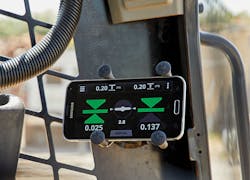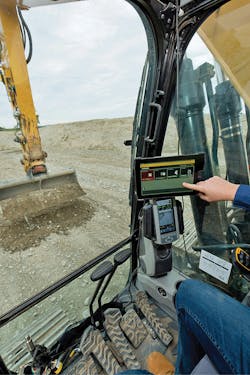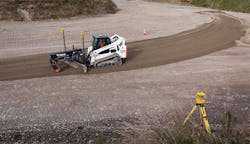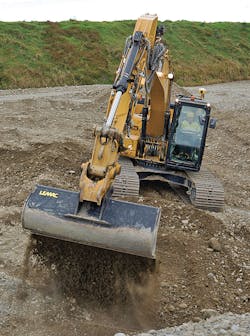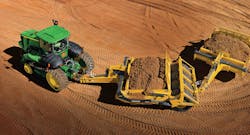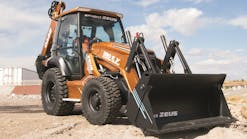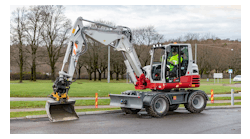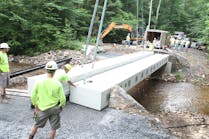You’ve certainly heard about self-driving cars, home assistants that listen for our commands, and delivery robots that can “see” where to deliver goods. What if that sci-fi-like power were in the hands of today’s grading and excavation operators?
How would that be possible? Look no further than machine control. Machine control is making it possible for heavy machinery to “see” the landscape before them, “think” about the steps needed to achieve the job, and show the operator what needs to be done.
Of course, no machine control can replace an operator. Think of it more like a GPS—you still need a driver, but you spend less time fighting with your passenger about which sideroad to take and more time singing to Brad Paisley on the radio.
Machine control includes the automated systems inside many types of modern heavy machinery that assist operators in the best ways to adjust their tools, such as a blade, to get the sought-after solution, such as a specific grade. It often uses GPS or other geo-positioning software to examine the machine’s location and the terrain in the targeted area. The machine control system is displayed on a screen within the machinery’s cabin and is typically connected to a local base station. Machine control replaces operators’ informed guesses about where to position the blade for the targeted grade and typically makes it possible to finish jobs faster with the same quality results.
Machine control is nothing new, but what’s new within the machine control industry might just blow your mind. The latest, greatest machine control mechanisms often look more like tablet displays and perform with the experience of a 30-year job site veteran. The latest machine control technology for grading and excavation work has enhanced user interface features and screens, better-quality sensors, and additional features that eliminate the danger of some onsite jobs.
Screens Like Smartphones; Insights Like Experts
Manufacturers of grading and excavation equipment often offer machine control within the equipment when it’s built, often due to the surge in demand for these features.
Jason Anetsberger, Senior Product Manager for Komatsu America Corp., says machine control aims to give operators extra assistance that is akin to having a top-notch contractor speaking in your ear.
“Komatsu’s proactive dozing combines the accuracy and optimization of the technology with the understanding and visualization of a 30-year dozer veteran,” he says. “The fact that customers are wholeheartedly adopting the technology is overwhelming proof of its impact.”
The displays are similar to today’s smartphones and tablets, and they’re even able to offer 3D models.
“The displays have moved to touchscreens that are like your smartphones. You can zoom, swipe, and rotate the 3D model right on the screen,” says Scott Hagemann, a marketing professional who specializes in grade technologies at Caterpillar Global Infrastructure and Construction.
Some of his company’s newest offerings were such a hit that customers often start swiping around the screen and chatting with their coworkers about how cool the features are—like testing out a new phone at a store at the mall, he says.
“When they get in the cab and see this, it is like a little kid on Christmas day,” says Hagemann. “It draws them to start touching the screen and then they start talking about how easy it is to use and navigate.”
Plus, he adds, there’s the extra benefit of being able to eliminate stress related to storing away GPS antennas because the GPS is now integrated into the machine itself.
“You can’t even see them from the ground on some of our tractors,” he says. “This helps keep them from theft, out of harm’s way, and removes any unsafe practices of removing them at the end of the day.”
Scott Crozier, general manager for Trimble, which produces products for the civil engineering/construction industries, in the Civil Engineering and Construction Division, says customers are so thrilled about the 3D graphics and the ability to automate decisionmaking that some customers are buying machine control devices by the armful.
“It’s actually been fun to see customers respond to how easy it is to learn and use Trimble Earthworks. One customer, in particular, had never used machine control before but was impressed by a Trimble Earthworks demo and ended up purchasing a system,” he says. “He taught himself how to use it by using the on-board menus and displays, and promptly purchased 10 more systems for the rest of his equipment fleet.”
Sean Mairet, Product Marketing Manager for grade control at John Deere, says operators have told him they’ve never seen technology like this before machine control became popular. In some ways, it feels like the answer to many operators’ frustrated wishes.
“The SmartGrade motor graders continue to knock the socks off of operators,” he says. “Not only does the system accuracy ‘wow’ veteran operators, but the ability to run the grader without limiting configuration truly has been a game-changer for anyone who is frustrated by current system limitations. Combine that freedom with the ability to add aftermarket systems like laser receivers, sonic tracers, or mmGPS receivers; the versatility of these machines are truly unrivaled.”
Changes in Efficiency
Crozier says machine control is “an important step toward complete machine automation” because it helps operators make the best decisions possible based on preprogrammed calculations of the current conditions on the job site.
“It allows operators to achieve grade consistently, with high accuracy and in less time,” he says.
All of that leads to getting jobs done faster and with less stress on the machines—which leads to fewer injuries, fewer unnecessary repairs, and less stress for operators.
Hagemann says operators who are relatively inexperienced are poised to gain the most benefit from machine control, rather than an operator who has been using their equipment for decades. Even so, experienced operators stand to gain some benefit from machine control.
“When set up and trained properly, I would say every operator would see some increase in efficiency and productivity,” he says. “You have to remember the increase is in comparison to the operator’s skill without onboard technology. We see newer operators getting more gains based on their lack of operator experience.”
Anetsberger says an experienced operator with machine control can essentially run an entire job site on their own—something unheard of with previous technology.
“It is the single most impactful change to earthmoving operational efficiency that I’ve personally seen in the industry,” he says. “So often today, we now see the operator in an intelligent machine control dozer running the entire site—they design and target grades, they decide where the trucks should dump, and they direct the compactors.”
He says changes in the user interface have made machine control functions simpler to learn. That simplicity comes with a lot of power, but when it comes to any technology’s learning curve, sticking to well-known instructions like using a finger to swipe around a screen can be quite helpful.
“Colorful graphics, natural interactions and gestures, and self-discovery features make the software intuitive and easy to learn,” says Anetsberger. “Each operator can personalize the interface to match their workflow, and a variety of configurable views make it easier to see the right perspective for maximum productivity.”
Operators are certainly not being replaced by machine control, but machine control does make their lives simpler when trying to get a job done on time and as perfectly as possible, Mairet says.
“Machine control has significantly increased efficiency and productivity by reducing the operator’s workload,” he says. “This has a compounding effect, as contractors are still able to produce quality results with less experienced operators and more experienced operators are able to focus on more complicated tasks.”
As a result, operators are able to reduce the number of passes they have to use to finish a job—saving fuel, time, and wear/tear and also avoiding injuries—while achieving a high level of accuracy.
Who’s Really UsingMachine Control?
Hagemann says adoption of machine control is keeping at a steady pace and is “continuing to grow.” However, he says it’s not always a feature that can be explained in words and images alone.
He says the experience of using machine control is really what draws in users. Once someone gets used to using machine control in their daily job site work, it’s tough for them to imagine life without it, he says.
“This is something you need to experience to embrace. Those that have it won’t give it up. The first reason they might not embrace it would be they have not tried it. You don’t know what you’re missing,” he says. “The second would be they don’t want to invest the money.”
He gets it, he says. It might not seem like a necessary expense. But ask yourself this: How much money do your operators cost you in fuel and maintenance costs when they run an hour later than expected? How much do you spend while getting a new hire up to speed on a dozer—someone who may have to do extra passes each time to get the grade just right (or who may have even misjudged their blade’s angle and required some time to fix their mistakes)?
“This increase in efficiency and productivity [due to machine control] is due to an investment of funds,” says Hagemann. “You got to pay to play.”
Anetsberger says the adoption rate of machine control and its newest features is astoundingly fast.
“These new automation features…become so intuitive to operators that we’re seeing the usage of automation skyrocket,” he says.
Companies have taken to heart customers’ requests for various features, he says, and now operators are seeing features that they thought were impossible to integrate.
“We’re at a point that the technology has really caught up to operators’ imaginations and delivers what they want—what they might have dreamed of a few years ago,” he says. “What we find now is that the systems are so capable that we are simply training the operators on the new functions and coaching customers on how best to integrate it into their operations.”
Crozier agrees, saying he’s seen utilization and adoption of machine control skyrocket over the past few years.
“Contractors are definitely embracing the use of machine control technology now more than ever. In fact, we’re seeing double-digit, year-over-year growth in adoption,” he says.
The efficiency boost that’s provided by machine control makes it a very important business move for some contractors, he adds.
“It’s become mainstream enough now that it’s hard for contractors without it to compete with those who have it. The technology allows operators to work so much more efficiently and accurately that those who aren’t using yet are at a distinct disadvantage,” he says.
Mairet says machine control adoption continues to increase and has certainly become the standard operating procedure for the modern operator and contractor.
“What once was only used on select jobs has become the norm for contractors looking to improve their efficiency and productivity,” he says. “While contractors may have initially been apprehensive of grade control technology, the value it brings to the job site is difficult to ignore.”
The various types of new features used in today’s machine control user interfaces have helped speed up adoption because intuitive features make operators feel more comfortable, and the fact that this equipment can come with machine control already installed (and, as important, with troubleshooting support staff members just a call away) create a “one-stop-shop” for the equipment and the regular support to maintain it.
Machine control can also help prevent accidents and improve safety as a whole on job sites, Crozier says. He says machine control can eliminate the need for staking, thus keeping workers at a safe distance away from heavy equipment while it’s in motion.
Crozier says increased adoption of machine control is also attributed to a current workforce shortage because it helps speed up training for new hires and gives younger, less experienced operators an extra boost.
“The technology helps level the playing field for less experienced operators. Machine control—and especially Autos—allows contractors to cast a wider recruiting net because beginner operators can work quickly and accurately,” he says.
Hagemann says that 15 years ago, onboard technology was just beginning to be introduced as a neat add-on feature. Today? Customers are demanding it.
“Now customers are demanding it and the product groups are designing for it,” he says. “I truly believe that if you don’t adopt it, you will not be in business.”
Mairet says over the past years, secondary companies often took up the mantle and created technology that could be added in afterward. But now, OEM solutions are the norm and are what customers demand, he says.
“The machine control industry has been changing over the past few years by moving from aftermarket masted systems to OEM integrated mastless solutions,” he says.
Anetsberger says adoption of this technology isn’t looking like it’s slowing down anytime soon. In fact, there are still plenty of innovations that operators are asking companies to create.
“Komatsu has over 4,000 intelligent machines in the US and Canada alone working day in and day out on job sites,” he says. “We expect that number to grow at ever-increasing rates given the increased value of our new automation features.”
He says today’s machine control capabilities are just the tip of the iceberg. Some of his company’s newest tech adds in capabilities like aerial mapping, 3D job site progress tools, and expert coaching, but there are many more operator-focused inventions to discover.
Crozier adds that some of those innovations will be in the small-contractor industry. Machine control can help these contractors compete in their market and use their resources to their fullest, he says.
“It’s important to note that machine control isn’t just for big contractors with big teams and big projects. These days, there are options available that can really move the needle for small contractors, or contractors working on smaller projects,” he says.
Crozier says machine control solutions for small contractors that his company has developed often focus on looking to the future needs of these contractors. It aims to make the system simple to use and runs on the operator’s existing smartphone, much like many of the modern technophile’s tools.
“Adopting machine control technology can help small contractors compete with bigger companies and can improve accuracy and efficiency even for small jobs with simple slopes. We believe this is an important and growing part of the market, and one we continue to invest in and innovate for,” he says.
Mariet says original equipment manufacturers will also be looking at machine control as a way to track data on the machines they’re attached to. By using this data, manufacturers can make even better machines in the future, with even better machine control features. It’s a win-win for operators and fleet managers, as well as for the companies who create the technology and machines.
“OEMs are taking advantage of the information available on the machine and fusing that with the integrated grade control solution, optimizing the overall machine productivity,” he says. “In the long-term, improvements in technology will bring additional opportunities to further reduce operator workload and improve productivity and efficiency.”
